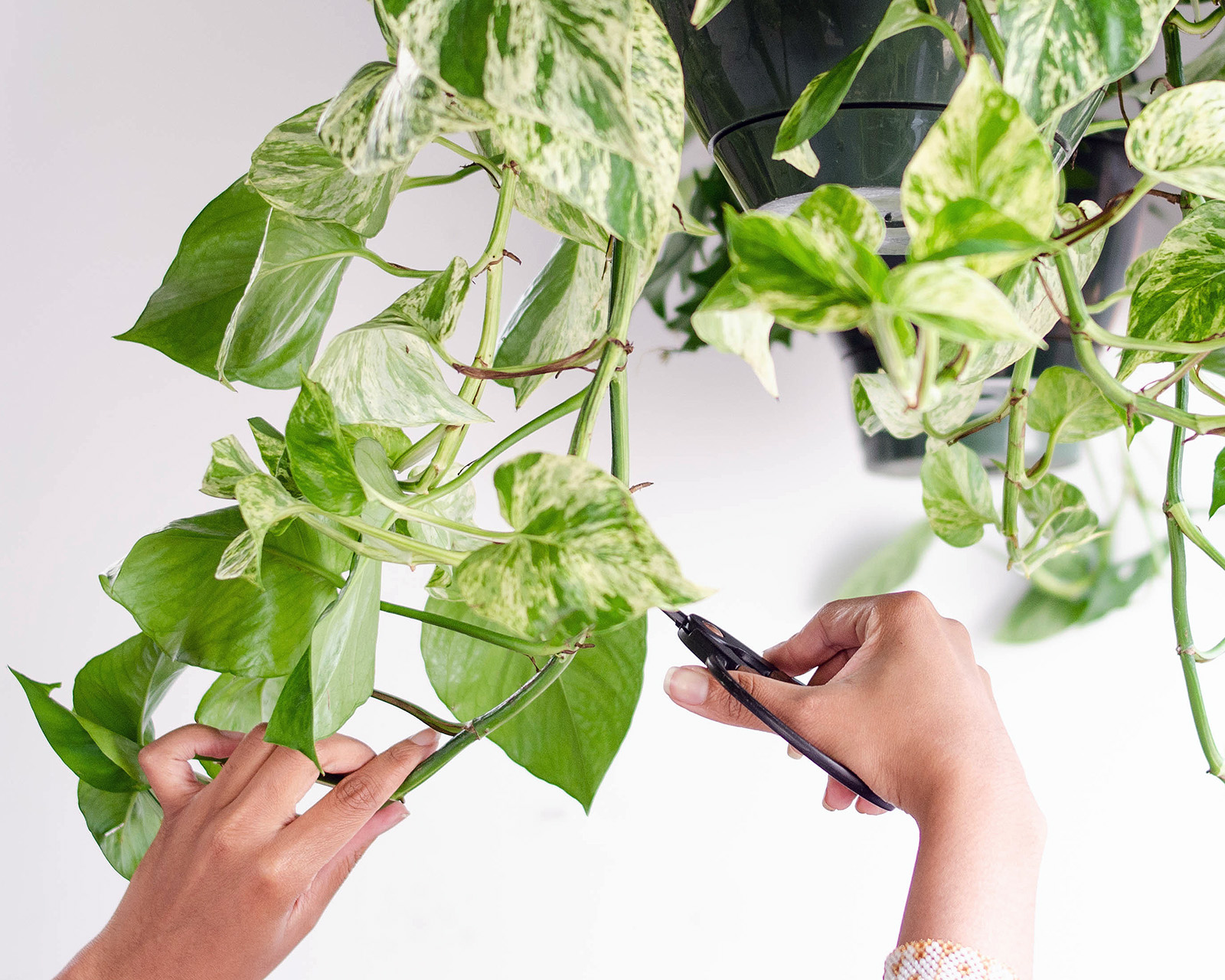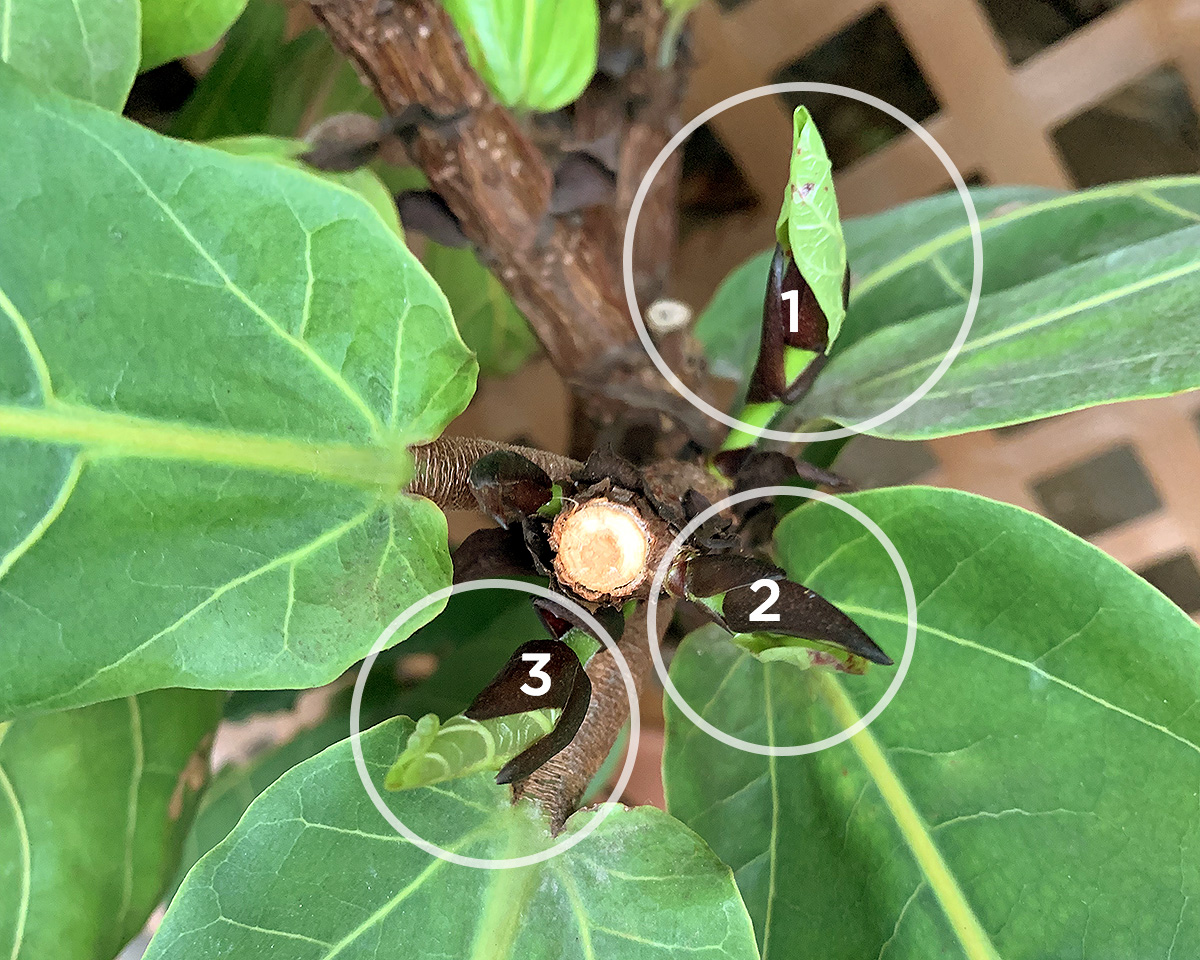Guide to Pruning & Shaping Your Plants
Pruning is defined, according to the dictionary, as “trimming (a tree, shrub, or bush) by cutting away dead or overgrown branches or stems, especially to increase fruitfulness and growth.”
Whether you’re just starting out with caring for plants, or you’re managing an indoor jungle, pruning plants is an activity that everyone can do at one point or another. It’s good for your plants for a variety of reasons: it helps keep pests and disease away, it prevents your plants from getting too sparse, and it allows your plants to retain a shape and size suitable for indoor spaces. In this journal post, we’ll cover everything you need to know to successfully trim and shape your plants, why it’s important, and different techniques to use for both vines and trees to encourage intentional growth.
The Basics
Successfully trimming and shaping your houseplants doesn’t require anything more than a good, clean pair of gardening shears or scissors and some general knowledge of how plants work.
Pruning and cutting away leaves, stems, and branches — in most cases — doesn’t harm your plant. In fact, it’s healthy to do this every now and then. Plants will benefit from a good trimming the most during spring and summer, which are their active growing seasons. Trimming can be done to both vines and trees to encourage new, fuller growth along the plants, as well as to get rid of any yellowing or dead sections. Whether you’re wanting to maintain a certain size, encourage branching, or achieve a certain look, pruning is one of the best ways to gain control over how your plant is growing.
Most houseplants can be pruned and cut, however, there are certain kinds that care should be taken with— these include most palms and tree ferns. Dead fronds and leaves can be removed, but these plants never form branches, so the top areas of growth shouldn’t be cut off, otherwise it will effectively kill the plant.
Pulling Away Yellow or Brown Leaves
Trimming or plucking away yellowing or dead leaves is an easy way to help prevent any unwelcome plant pests from settling onto your plant, which are attracted to decaying or dead leaves more than healthy ones, and they are more likely to appear on a struggling plant.
Pulling away yellowing or dead leaves is also a good way to keep your plant looking its best. When a leaf is yellowing, let the leaf fully turn yellow before pulling it off. When a leaf is on its way out, the leaf loses all of its chlorophyll (the molecules which make the leaf green), and the plant absorbs any leftover nutrients from the yellowing leaf. The leaf should be able to be pulled off easily without any kind of resistance. Any leaves that have turned brown and crispy can also be pulled off of a stem or branch without harming your plant.
Trimming off brown leaf edges will not harm the plant and is a way to make the overall plant look more appealing
Pro tip : try to trim in a way that mimics the original, natural shape of the leaf
Seasonal vs. Daily Pruning
Some tasks, when it comes to trimming and pruning houseplants, should be done during certain times of the year. It’s best to get any large amounts of pruning done during the spring or summer, when your plants are getting more sunlight and are actively growing. Trimming off a large amount of leaves, branches, or anything that will cut back a sizable amount of your plant, is best done during this time. In general, you don’t want to remove any more than 1/4 of the overall foliage of the plant. Hold back on any major pruning during the fall and winter — your plants won’t be growing as quickly, and it could take a longer time for them to put out new growth or recover from being trimmed too much. However, there are tasks that can easily be accomplished during any time of the year. Pulling off yellowing or brown leaves, trimming away a few stems or vines, or other smaller items, can all be done daily or as needed throughout the year to keep your plants looking healthy.
Pruning Trees
Like trees living outdoors, indoor trees should occasionally be pruned to help maintain their shape and growth. Likewise, if they’re getting too large for your space, it’s a good idea to shape and prune them. Pruning trees is also a great way to thin them out a bit. Not only does this make them more visually attractive, but it also improves air flow between leaves and branches, leading to an overall healthier plant.
Indoor trees, such as Ficus and Dracaenas, tend to grow vertically, but it is possible to encourage branching by trimming off the topmost point of growth. Doing this will force your plant to branch out from the sides of where you cut, rather than continuing to grow directly upwards. By branching off of this idea, you can control where and how your plant grows, allowing you to tailor your tree’s growth to suit your indoor space.
When an existing branch is pruned, new branches will sprout from beneath the area where the cut was made. In this photo, the Fiddle Leaf Fig tree is sprouting 3 new branches.
Here you can see where the main branch was pruned and two more branches have since grown and matured from below the cut.
Pruning Vines
Like trees, vines can be pruned regularly to keep them from getting too leggy and to encourage a fuller appearance. Vines such as Pothos and some varieties of Philodendrons benefit most from regular pruning. Besides pulling away dead or yellow leaves, it’s possible to get most vines to look bushier and more full via pruning. To accomplish this, trim either directly below a leaf or occasionally pinch off new growth with your fingers to get your plant to sprout new vining stems off of an old one — this keeps your plant looking compact and full, rather than having sparse, single vines trailing down a planter.
Propagating with Cuttings
You may be left wondering what to do with any branches, vines, or stems you’ve cut away from your plants. To preserve all parts of your plant, you can usually propagate them by sticking them directly into water or soil. Most branches root readily, as do cuttings from plants like Sansevieria, ZZ plants, Hoyas, and others. For vines such as Pothos, Philodendrons, and Monsteras, you’ll want to cut directly below a node or aerial root. Sticking this part into water or soil, will allow for water or soil roots to grow and sustain the cutting as it continues to grow.
Here, a Pothos cutting is beginning to root in water.
With all of this information, hopefully you’re well-equipped to prune and trim your plants to keep them looking (and being!) healthy and happy. If you have any questions, feel free to comment below or come visit us in one of our shops!
Written by: Egan Thorne
Photos by: Michelle Carr



